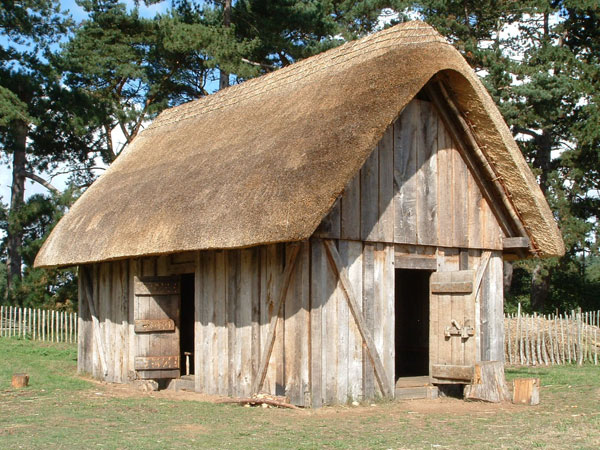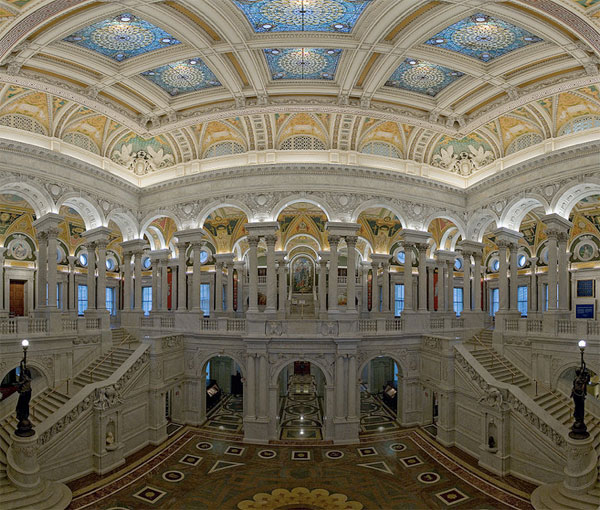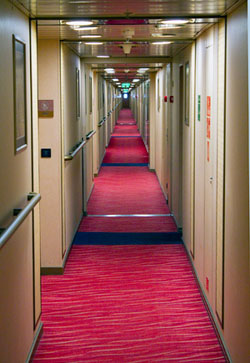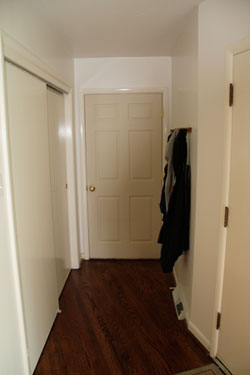Hall
by Roger Kaza
Today, a room without a view. The University of Houston presents this program about the machines that make our civilization run, and the people whose ingenuity created them.
If you've been house-hunting lately, or glanced at an ad or flyer, the following spiel will sound familiar: three-bedrooms, two baths. Perhaps a family room, den, gameroom or study. Of course a kitchen, living room, dining room. Maybe a walk-in closet or two. We're interested in rooms. Curiously, the only room that is almost never mentioned is the one that used to be, well, the entire house.
I'm referring to that humble space, the hall. Bill Bryson has now written a delightful book At Home, A Short History of Private Life. He tells us that the word "hall" is one of the oldest in the English language. We can apparently thank the Angles for that, as in Anglo-Saxon, or Anglophile or even the name England itself. The Angles were one of many land-hungry European tribes roaming around in the 5th century of the common era. Franks, Saxons, Goths, Huns, Magyars were some of the others. All were testing the territorial waters, scrambling to fill the power vacuum left by a crumbling Roman Empire. The Angles sailed to Britannia from North Germany and made themselves right at home. According to Bryson's sources, it wasn't a particularly violent 'invasion.' More like houseguests who never left.

Reconstruction of an Anglo-Saxon hall
For some reason, the Angles and Saxons weren't enamored with the homes the Romans had left behind. So they built their own. What they built were large, barn-like structures: wooden one-room dwellings with a hearth in the middle. They called them 'halls.' Originally, the hall accommodated everyone: the lord of the manor, his family and servants or slaves. Everyone ate, worked and slept in the barracks-like room. This is the 'hall' that Beowulf would have known.
Over the centuries, hall was updated a bit. Partitions were added for the lord. A separate kitchen. Perhaps a chapel. By the end of the 14th century we even had a room called the parlour. Hall then morphed into the "great hall," still the largest room in the house. But by the Renaissance even this changed. Houses were now divided into multiple stories. The great hall lost its vertical reach, and was no longer particularly great. In fact, it was just another room on the main floor'which we stopped calling 'hall.' The hall became the front entryway, still found in many homes. It also came to refer to passageways leading from one room to the next.
Quite the hard luck story! "Hall" goes from meaning the whole house, to a significant portion of the house, to a smallish, non-descript space in the house. It went from foremost to forgotten. Or, it almost did. After we more or less ejected hall from our homes, it kind of made good on its own. Think of it: Carnegie Hall in New York, Jones Hall in Houston, a Hall of Fame. Dining halls. Various halls at colleges and universities. Hall shed private life and became an exclusively public citizen: large, often imposing places we visit but eventually leave. Unlike the Angles, who crossed the North Sea 1600 years ago — and stayed.

Great Hall of the Library of Congress. Photo by David Illif
I'm Roger Kaza, from the University of Houston, where we're interested in the way inventive minds work.
As mentioned, this episode is largely derived from At Home, A Short History of Private Life, by Bill Bryson. (Doubleday, 2010) Bryson's book chronicles the evolution of the private home, using an 1851 English rectory as a touchstone.
The main account of the Anglo-Saxon takeover of Britain comes from the Venerable Bede (c.673-735), three centuries after the fact:
"The Angles were invited here by King Vortigern, and they came to Britain in three longships, landing at Ebbesfleet. [He] gave them territory in the southeast of this land on the condition that they fight the Picts. This they did, and had victory wherever they went. Then they sent to Angel and commanded more aid they soon sent hither a greater host to help the others. Then came the men of three Germanic tribes: Old Saxons, Angles and Jutes. Of the Jutes come the people of Kent and the Isle of Wight; of the Old Saxons come the East-Saxons, South-Saxons and West-Saxons; of the Angles come the East Anglians, Middle Anglians, Mercians and all Northumbrians. Their war-leaders were two brothers, Hengist and Horsa, first of all they killed and drove away the king's enemies, then later they turned on the king and the British [mid-450s], destroying through fire and the sword's edge." Bede, quoted in The Anglo-Saxon Chronicle.
Two conflicting views of British ancestry:
See also Engines No. 2199. A seemingly opposing view described in the UK Daily Mail, which posits that the Germanic tribes basically outbred the native Celts, over a period of several hundred years, rather than destroying them.
Hall(concept) Wikipedia entry.

Hallway from the Motor Ship Zaandam. Photo by J. Lienhard

The author's grand entry hall
Photo credits:
Anglo-Saxon Hall photo courtesy St.Edmundsbury Borough Council, West Stow Anglo-Saxon Village
Library of Congress photo courtesy Wiki Commons. License info.
This episode was first aired on September 2nd, 2011